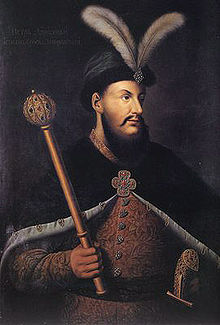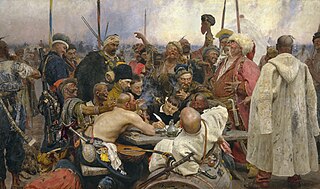
The Cossacks are a predominantly East Slavic Orthodox Christian people originating in the Pontic–Caspian steppe of eastern Ukraine and southern Russia. Historically, they were a semi-nomadic and semi-militarized people, who, while under the nominal suzerainty of various Eastern European states at the time, were allowed a great degree of self-governance in exchange for military service. Although numerous linguistic and religious groups came together to form the Cossacks, most of them coalesced and became East Slavic-speaking Orthodox Christians. Additionally, Cossack units were later established in Persia, notably the Persian Cossack Brigade, formed in the late 19th century with Persian troops, which played a significant role in Iran’s military and political landscape in the early 20th century.

The Russo-Turkish War of 1676–1681, a war between the Tsardom of Russia and Ottoman Empire, caused by Turkish expansionism in the second half of the 17th century.

Hetman of Zaporizhian Cossacks is a historical term that has multiple meanings.

Petro Konashevych-Sahaidachny was a political and civic leader, who was a Hetman of Ukrainian Cossacks from 1616 to 1622. During his tenure, he transformed Zaporozhian Cossacks from irregular military troops into a regular army and improved relations between the Cossacks, the Orthodox clergy and peasants of Ukraine, which would later contribute to the establishment of a modern Ukrainian national consciousness. A military leader of the Polish–Lithuanian Commonwealth both on land and sea, Sahaidachny is best known for the significant role his troops played in the Battle of Khotyn against the Ottoman Empire in 1621, as well as the Polish Prince Władysław IV Vasa's attempt to usurp the Russian throne in 1618.
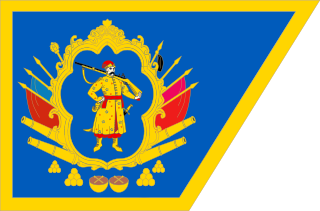
The Cossack Hetmanate, officially the Zaporozhian Host, is a historical term for the 17th–18th centuries Ukrainian Cossack state located in central Ukraine. It existed between 1649 and 1764, although its administrative-judicial system persisted until 1781.
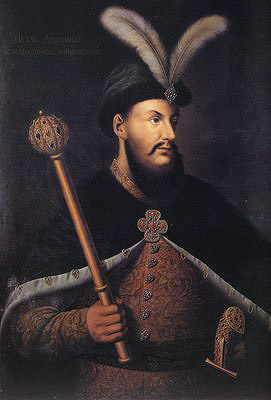
Petro Dorofiyovich Doroshenko was a Cossack political and military leader, Hetman of Right-bank Ukraine (1665–1672) and a Russian voivode.

Ivan Dmytrovych Sirko was a Zaporozhian Cossack military leader, Koshovyi Otaman of the Zaporozhian Host and putative co-author of the famous semi-legendary Cossack letter to the Ottoman sultan that inspired the major painting Reply of the Zaporozhian Cossacks by the 19th-century artist Ilya Repin.
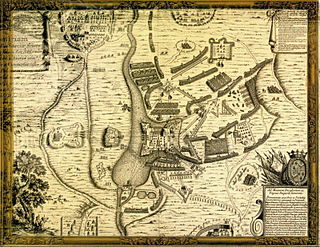
The Russo-Polish War of 1654–1667, also called the Thirteen Years' War, Muscovite War of 1654–1667 and the First Northern War, was a major conflict between the Tsardom of Russia and the Polish–Lithuanian Commonwealth. Between 1655 and 1660, the Swedish invasion was also fought in the Polish–Lithuanian Commonwealth and so the period became known in Poland as "The Deluge" or Swedish Deluge/Russo–Swedish Deluge'.
The Ruin is a historical term introduced by the Cossack chronicle writer Samiilo Velychko (1670–1728) for the political situation in Ukrainian history during the second half of the 17th century.

The Battle of Konotop or Battle of Sosnivka was fought between a coalition led by the Hetman of Zaporizhian Cossacks Ivan Vyhovsky and cavalry units of the Russian Tsardom under the command of Semyon Pozharsky and Semyon Lvov, supported by Cossacks of Ivan Bezpaly, on 29 June 1659, near the town of Konotop, Ukraine, during the Russo-Polish War (1654–1667). Vyhovsky's coalition defeated the Russians and their allies and forced the main Russian army to interrupt the siege of Konotop. However, the result of the battle only intensified political tensions in Ukraine and led to Vyhovsky's removal from power several months later.

Ivan Briukhovetsky was the hetman of left-bank Ukraine from 1663 to 1668. In the early years of rule, he positioned himself on pro-Russian policies, but later joined a rebellion in an attempt to salvage his reputation and authority. Later, he was the leader of an anti-Russian uprising in 1668. He was beaten to death by a mob supported by Petro Doroshenko.

The Polish–Cossack–Tatar War was fought between the Polish–Lithuanian Commonwealth and the Ottoman-allied states of the Cossack Hetmanate and the Crimean Khanate. It occurred in the aftermath of the Russo–Polish War of 1654–1667 and was a prelude to the Ottoman–Polish War of 1672—1676.

Mykhailo Stepanovych Khanenko was a Ukrainian Cossack military leader, and nominal hetman of Right-bank Ukraine from 1669 to 1674 in rivalry with Petro Doroshenko during The Ruin.
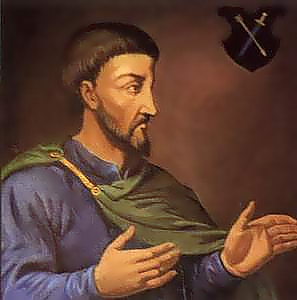
Demian Ihnatovych (Mnohohrishny) (Ukrainian: Дем'ян Многогрішний) (1621, Korop – 1703) was the Hetman of Left-bank Ukraine from 1669 to 1672. See The Ruin (Ukrainian history)

The Battle of Podhajce was fought in the town of Podhajce in the Polish–Lithuanian Commonwealth, and the area surrounding it as part of the Polish-Tartar War and the Great Turkish War. The army of the Polish–Lithuanian Commonwealth under John III Sobieski, totaling around 9,000 men, defeated Tatar and Cossack forces under Petro Doroshenko and Adil Giray, which totaled around 35,000 men.

Ottoman Ukraine, Khan Ukraine, Hanshchyna was the right-bank Ukraine, also known by its Turkic name Yedisan. The first recorded use of the term Khanska Ukraina are traced to 1737 when the Russian secret-agent Lupul urged Empress Anna of Russia to attack Ottoman Ukraine.

The Hetman of the Zaporozhian Host was the head of state of the Cossack Hetmanate. The office was abolished by the Russian government in 1764.

Prince Władysław's March on Moscow was a military conflict between the Polish-Lithuanian Commonwealth and the Tsardom of Russia, which lasted from 1617 to 1618. The war ended with the signing of the Truce of Deulino. It is considered the final stage of the Polish–Muscovite War (1609-1618).

Battle of Kaniv, was a battle during the summer campaign in the left-wing Ukraine of Yuri Khmelnitsky, between the Cossack-Polish troops and the Russian-Cossack army led by Yakim Somko and Grigory Romodanovsky. The battle ended with a crushing defeat for Yuri Khmelnitsky and the hetman's retreat to right-bank Ukraine.

Siege of Kyiv or Defense of Kyiv was a siege of Kyiv by troops led by Daniil Vyhovsky, whose garrison was commanded by the Russian Commander Vasily Sheremetev. As a result of the battle, Russian troops completely defeated the Cossack regiments and successfully defended Kyiv.


